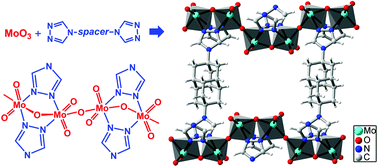Metal oxide-organic frameworks (MOOFs), a new series of coordination hybrids constructed from molybdenum(vi) oxide and bitopic 1,2,4-triazole linkers†‡
Abstract
A series of

* Corresponding authors
a
Inorganic Chemistry Department, National Taras Shevchenko University of Kyiv, Volodimirska Street 64, Kyiv, Ukraine
E-mail:
dk@univ.kiev.ua
b Institut für Anorganische Chemie, Universität Leipzig, Linnéstraße 3, Leipzig, Germany
c Department of Organic Chemistry, Kyiv Polytechnic Institute, Peremogy Ave 37, Kyiv, Ukraine
d Institute of Organic Chemistry, Justus-Liebig University, Heinrich-Buff-Ring 58, Giessen, Germany
A series of

 Please wait while we load your content...
Something went wrong. Try again?
Please wait while we load your content...
Something went wrong. Try again?
A. B. Lysenko, G. A. Senchyk, J. Lincke, D. Lässig, A. A. Fokin, E. D. Butova, P. R. Schreiner, H. Krautscheid and K. V. Domasevitch, Dalton Trans., 2010, 39, 4223 DOI: 10.1039/B922732F
To request permission to reproduce material from this article, please go to the Copyright Clearance Center request page.
If you are an author contributing to an RSC publication, you do not need to request permission provided correct acknowledgement is given.
If you are the author of this article, you do not need to request permission to reproduce figures and diagrams provided correct acknowledgement is given. If you want to reproduce the whole article in a third-party publication (excluding your thesis/dissertation for which permission is not required) please go to the Copyright Clearance Center request page.
Read more about how to correctly acknowledge RSC content.
 Fetching data from CrossRef.
Fetching data from CrossRef.
This may take some time to load.
Loading related content
